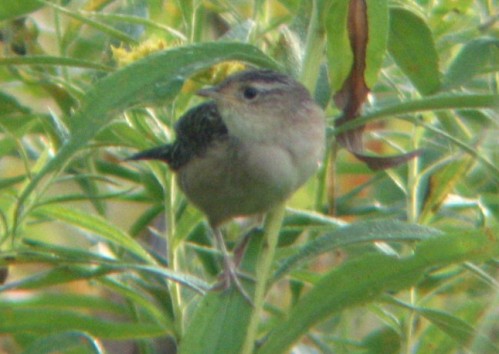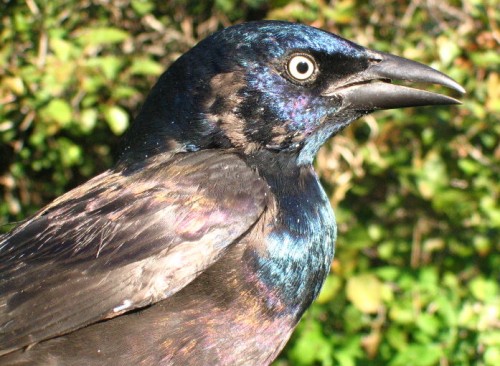|
McGILL BIRD OBSERVATORY |
||||||||||||||||||||||||||||||||||||||||||||||||||||||||||||||||||||||
Welcome
to the McGill Bird Observatory weekly report.
Click here for a complete listing of our archives.
Bander-in-charge:
Seabrooke Leckie Notes: After the lull of week 5, the 6th week of fall 2006 opened with a bit of excitement. A total of 40 birds were captured, which, while not overwhelming, kept staff on their feet most of the day. The best bird to enter the nets on Tuesday wasn't banded - the same immature Red-shouldered Hawk that escaped from the nets two weeks ago did it again. One of these days! Other captures (these ones were banded) included a lateish Yellow Warbler, four Rose-breasted Grosbeaks and one of the season's early Ruby-crowned Kinglets, and a Winter Wren and a Blue-headed Vireo, both new for the season, were recorded on census. In case the hawk wasn't enough excitement, the third Sedge Wren to be seen at the station was spotted by sharp-eyed volunteers. It's difficult to say if these sightings have all been the same individual or different ones, or if they might be young from the nearby Arboretum - it's too bad they seemed to have no interest in the nets! On Wednesday we were well staffed and were able to open up the full complement of nets for the first time this season. Nearly 60 birds were caught, which included 10 Magnolia Warblers, 5 American Redstart, 5 Wilson's Warblers and 4 Ovenbirds, as well as a smattering of other species. The first Rusty Blackbirds were seen early in the morning, and two Greater Yellowlegs were heard calling as they flew over the site. The interior of the station received a new floor layout and equipment that has really opened the space up (but you have to see it to believe it!). North winds overnight on the 7th, along with the sound of the early birds awakening upon arrival at the site, suggested promise for activities for the morning. However, the nets remained about as active as the previous couple of days, as just 43 birds were caught. A large portion of these (12 birds) were Common Grackles captured on one round as a flock came down to rest briefly near some of the nets. The first Blue-headed Vireo banded this fall was captured on Thursday, as well as good numbers of Lincoln's Sparrows. A hatch-year Common Yellowthroat caught late in the morning was the 1000th bird banded for MBO this season. Moderate numbers of birds continued to pass through the site on Friday. A large rush on the first round contributed about half of the 38 birds captured for the morning. The majority of these were warblers from a large foraging flock, Philadelphia Vireo, Cedar Waxwings and several Lincoln's Sparrows. A Scarlet Tanager was among the flock members who avoided the net, and a Northern Parula was spotted on census. Rain early on the 9th delayed net opening for a couple of hours. The clouds finally cleared enough to allow for a few nets to be opened for the latter half of the morning. A total of 34 birds were banded from just 37 net hours - by far our highest capture rate so far this season. The influx in activity was well-timed, as a group from the COA came out for a demonstration of the MBO operations. The visitors were treated to a good variety of birds as several foraging flocks comprised of warblers, vireos and sparrows were captured. Everyone seemed to thoroughly enjoy the morning, and the extra eyes were of great value as the season's first Wilson's Snipe was spotted by the group. MBO gratefully acknowledges the donation from COA as a thank you for the tour. Sunday dawned cold enough to prompt staff to fire up the wood stove for the first time this season. A similar pattern of activity to Friday occurred, with a large portion of the birds captured on the first net round followed by slow but steady captures the rest of the morning. The season's first American Pipits were heard flying overhead at opening. The Brown Thrasher that we'd seen escape from the nets on at least two previous occasions this week was finally captured and banded. A female Black-throated Blue Warbler, Traill's Flycatcher and House Wren were other nice captures rounding out the morning. The 11th was similarly cold and clear, and brisk north winds overnight the area was noticeably quieter than previous days this week. A total of just 40 species was recorded for the day, our lowest of the week. An influx of Myrtle Warblers was noted in the area, as a total of 15 were recorded for the morning, although only two were captured. Another large flock of Common Grackles was encountered in the nets - a total of 21 were banded, but many more escaped before they could be extracted, to join the very large group perched in the trees beside the nets. The weekly banding total of 266 birds is our highest so far this season reflecting the increased movement of migrants as we move into the peak of warbler migration. Numbers of sparrows and late-season migrants such as kinglets are just starting to increase, and the weeks to follow are likely to be the most active and most diverse of the season.
While numbers were up considerably from last week, the dominant species didn't change all that much. Common Grackles leapt back to near the top of the banding list, and White-throated Sparrows have made their first appearance of the season there; odds are they will remain on it for the remainder of the fall. For now though, warblers continue to dominate the top ten when it comes to banding. Only a couple of them though were abundant enough to land among the top ten species observed. Crows and grackles continue to dominate that list by a large margin, while Black-capped Chickadee and Blue Jay have climbed into a tie for third place, perhaps indicative of some migration getting underway for these species.
|



